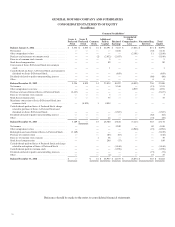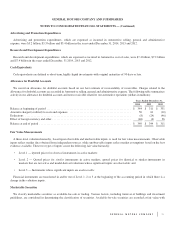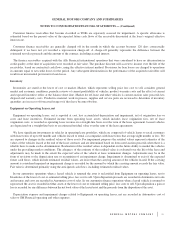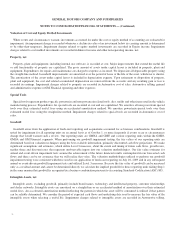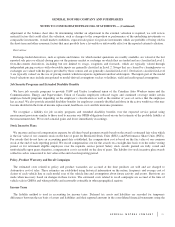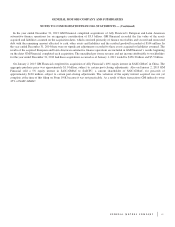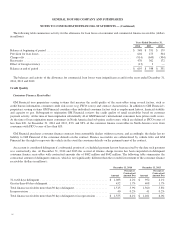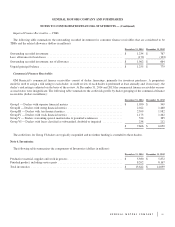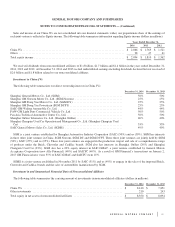General Motors 2014 Annual Report Download - page 78
Download and view the complete annual report
Please find page 78 of the 2014 General Motors annual report below. You can navigate through the pages in the report by either clicking on the pages listed below, or by using the keyword search tool below to find specific information within the annual report.GENERAL MOTORS COMPANY AND SUBSIDIARIES
NOTES TO CONSOLIDATED FINANCIAL STATEMENTS — (Continued)
Cash Equivalents and Other Short-Term Investments
Money market funds and other similar short-term investment funds are valued using the net asset value per share (NAV). Prices for
short-term debt securities are received from independent pricing services or from dealers who make markets in such securities.
Independent pricing services utilize matrix pricing which considers readily available inputs such as the yield or price of bonds of
comparable quality, coupon, maturity and type as well as dealer supplied prices. Money market mutual funds which provide investors
with the ability to redeem their interests on a daily basis and for which NAVs are publicly available are classified in Level 1. Other
cash equivalents and short-term investments are classified in Level 2.
Common and Preferred Stock
Common and preferred stock for which market prices are readily available at the measurement date are valued at the last reported
sale price or official closing price on the primary market or exchange on which they are actively traded and are classified in Level 1.
Such equity securities for which the market is not considered to be active are valued via the use of observable inputs, which may
include, among others, the use of adjusted market prices last available, bids or last available sales prices and/or other observable
inputs and are classified in Level 2. Common and preferred stock classified in Level 3 are those privately issued securities or other
issues that are valued via the use of valuation models using significant unobservable inputs that generally consider among others, aged
(stale) pricing, earnings multiples, discounted cash flows and/or other qualitative and quantitative factors.
Fixed Income Securities
Fixed income securities are valued based on quotations received from independent pricing services or from dealers who make
markets in such securities. Debt securities which are priced via the use of pricing services that utilize matrix pricing which considers
readily observable inputs such as the yield or price of bonds of comparable quality, coupon, maturity and type as well as dealer
supplied prices, are classified in Level 2. Fixed income securities within this category that are typically priced by dealers and pricing
services via the use of proprietary pricing models which incorporate significant unobservable inputs are classified in Level 3. These
inputs primarily consist of yield and credit spread assumptions, discount rates, prepayment curves, default assumptions and recovery
rates.
Investment Funds, Private Equity and Debt Investments and Real Estate Investments
Investments in exchange traded funds, real estate investment trusts and mutual funds, for which market quotations are generally
readily available, are valued at the last reported sale price, official closing price or publicly available NAV (or its equivalent) on the
primary market or exchange on which they are traded and are classified in Level 1. Investments in private investment funds (including
hedge funds, private equity funds and real estate funds) are generally valued based on their respective NAV (or its equivalent), as a
practical expedient to estimate fair value due to the absence of readily available market prices. Investments in private investment
funds, which may be fully redeemed at NAV in the near-term are generally classified in Level 2. Investments in funds, which may not
be fully redeemed at NAV in the near-term, are generally classified in Level 3.
Direct investments in private equity, private debt and real estate securities are generally valued in good faith via the use of the
market approach (earnings multiples from comparable companies) or the income approach (discounted cash flow techniques), and
consider inputs such as revenue growth and gross margin assumptions, discount rates, discounts for lack of liquidity, market
capitalization rates and the selection of comparable companies. As these valuations incorporate significant unobservable inputs they
are classified in Level 3.
Fair value estimates for private investment funds, private equity, private debt and real estate investments are provided by the
respective investment sponsors or investment advisers and are subsequently reviewed and approved by management. In the event
management concludes a reported NAV or fair value estimate (collectively, external valuation) does not reflect fair value or is not
determined as of the financial reporting measurement date, we will consider whether and when deemed necessary to make an
78




